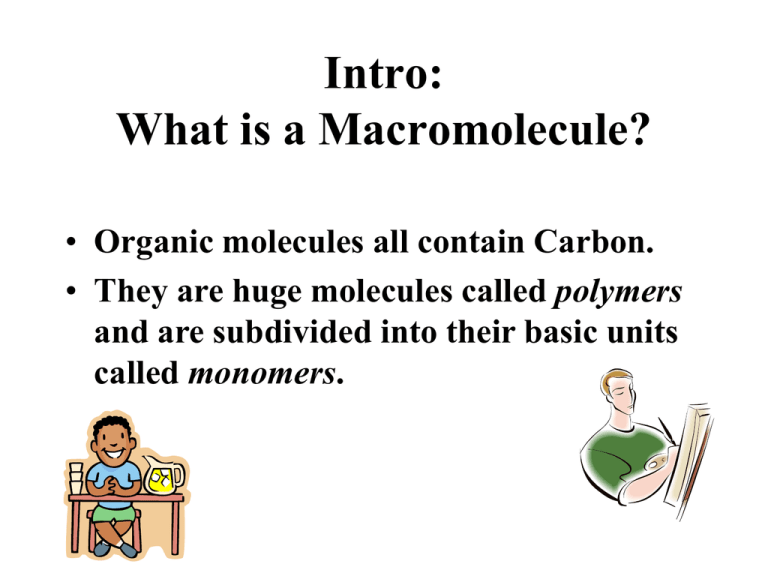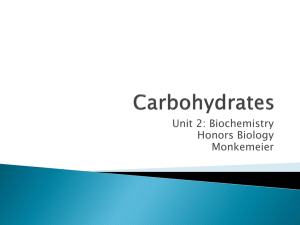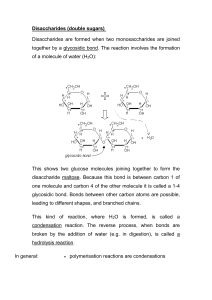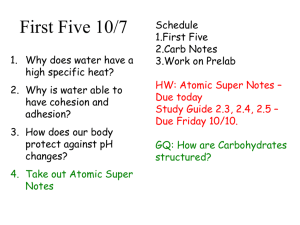CARBOHYDRATES
advertisement

Intro: What is a Macromolecule? • Organic molecules all contain Carbon. • They are huge molecules called polymers and are subdivided into their basic units called monomers. Macromolecules are made of many small subunits bonded together. – Monomers are the individual subunits. – Polymers are made of many monomers. Carbon is the skeleton of all organic molecules! •Carbon forms covalent bonds with up to four other atoms, including other carbon atoms. •Carbon-based molecules have three general types of structures. CARBOHYDRATES Carbohydrates: Carbon, Hydrogen, Oxygen CHO Carbohydrates • Small sugar molecules to large starch molecules. Carbohydrates Monosaccharide: one sugar unit glucose (C6H12O6) is blood sugar YUM! glucose Disaccharide: two sugar units glucose glucose units glucose glucose glucose glucose cellulose glucose Starch! glucose glucose glucose Carbohydrate Function - Used for Energy - Some provide structure Carbohydrate Examples Monosaccharides Glucose - Blood Sugar Deoxyribose - In DNA Fructose - Fruit Sugar Galactose - Milk Sugar glucose Disaccharide: two sugar unit Examples: –Maltose (glucose+glucose) in malt –Sucrose (glucose+fructose) is sugar –Lactose glucose glucose (glucose+galactose) in milk Polysaccharide: many sugar units Examples: starch (rice, potatoes, cereal) glycogen (starch in the liver) cellulose (lettuce, wood, fibers) glucose cellulose glucose cotton Lipids Lipid Facts: •Fats and oils are neutral, non-polar. •Not soluble in water. Lipid Structure: • A Neutral Fat is a Triglyceride • 3 Tails of Fatty Acid are attached to One glycerol molecule. • Fork-like shape: This is a model of 1 triglyceride (don’t write this). (Lipid monomers) How are oils different from fats? Unsaturated Fatty Acid Saturated Fatty Acid Solid fat Liquid oil Saturated Fat Facts • Saturated fats are solid at room temp. • Fats come from animals. • All Carbons are “saturated” with Hydrogen • “Hydrogenated oils” Unsaturated Fats/OIL Facts • Some C=C bonds • Less Hydrogen, some Carbons are unsaturated with H. • Liquid at room temp. • Oils come from plants Lipid Functions Six Functions of Lipids: 1. Long term energy storage 2. Insulation against heat loss (blubber) 3. Shock absorption 4. Prevents water loss 5. Chemical messengers ( steroid hormones) 6. Major component in membranes (phospholipids) Lipid Examples 1. Fats 2. Oils 3. Waxes (bees wax) 4. Phospholipids (cell membranes) 5. Steroids and cholesterol Proteins Proteins (Polypeptides) -Amino acids: 20 different types -Bonded together by a peptide bond to make polypeptides Protein Examples ENZYMES!!!! Hemoglobin - in your blood Muscles Nucleic Acids Nucleic Acids -Two Types: - Deoxyribonucleic acid (DNA double helix) - Ribonucleic acid (RNA - single strand) - Nucleic acids are composed of long chains of nucleotides - Nucleotides make up DNA - DNA stores genetic information - RNA builds proteins






